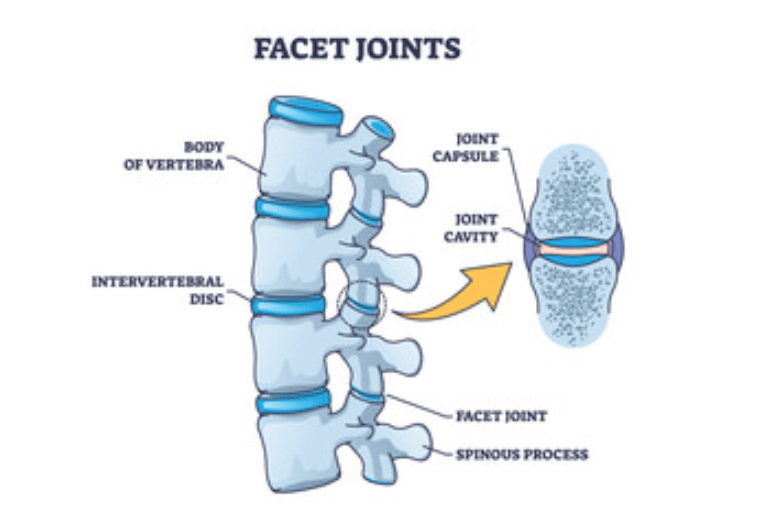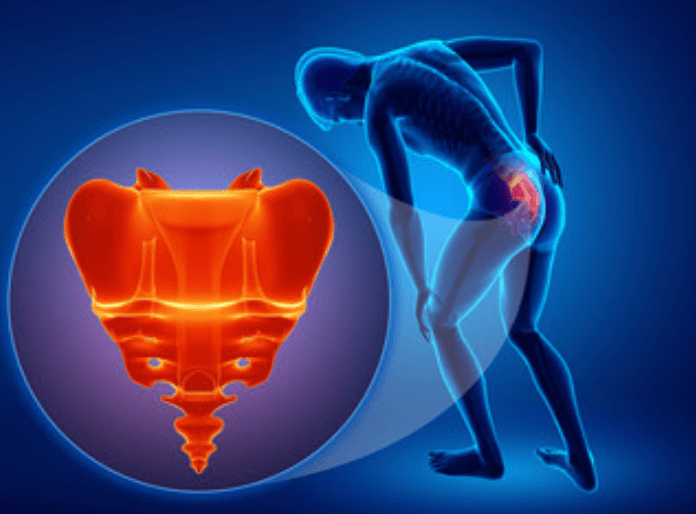Have you ever had back pain that wouldn’t go away? It could be due to facet joint syndrome, which affects the tiny joints on the backside of your spine.
These joints help your spine move smoothly while being stable. However, when they become inflamed or damaged, they may cause a variety of discomforts.
In this blog, I will tell you about the root causes of facet joint syndrome, how to recognize the symptoms, what precautions to take, and the various treatments available to fix it.
So, let’s dive in to understand and manage this condition!
Anatomy of facet joints
Imagine your spine as a stack of bones known as vertebrae. These bones connect and allow you to move.
Each vertebra has three joints: one large disc in the front and two small facet joints at the back.

This setup acts like a sturdy tripod, keeping your spine stable while still allowing you to bend and twist.
The facet joints are tiny hinges located at the back of each vertebra. They are covered in a smooth layer of cartilage and have fluid inside to help them move smoothly.
They also have a protective layer known as a joint capsule. When the facet joints are healthy, they allow your back to move smoothly without twisting too much.
Overview of facet joint syndrome
Facet joint syndrome, like arthritis, can cause severe back and neck pain. It occurs as the joints between the bones in your spine begin to wear down over time.

When this occurs, the cushioning inside these joints can degrade and become swollen. As a result, it will start sending pain signals to nearby nerves. To alleviate pain, doctors may recommend medications, physical therapy, joint injections, or other treatments to block or stop nerve signals.
However, in severe cases, surgery may be required to join the affected joints.
Causes of Facet Joint Syndrome
Facet joint syndrome, also known as facet arthritis, develops when the small joints in the spine become painful and inflamed.
These joints, known as facet joints, are paired structures that connect the vertebrae and play an important role in spinal movement while remaining stable.
There are several factors that may contribute to the development of facet joint syndrome. They are as follows:
Aging: Ageing is one of the leading causes of facet joint syndrome. Over time, the cartilage that cushions the facet joints may wear down. This causes friction, inflammation, and pain in the facet joints.
Spinal Conditions: Certain spinal conditions can raise the risk of facet joint syndrome. These include spinal stenosis (a narrowing of the spinal canal), herniated discs, spondylolisthesis (when one vertebra slips over another), and spinal osteoarthritis. These all-spinal conditions can increase stress on the facet joints.
Trauma and Injury: Facet joint syndrome can also be caused by a spinal injury. This includes accidents, falls, sports injuries, and repetitive stress on the spine caused by activities or occupations that require frequent bending, twisting, or heavy lifting. Such injuries can damage the facet joints and surrounding structures, causing inflammation and pain.
Posture and Movement: Poor posture, incorrect body mechanics, or repetitive movements that strain the spine can all contribute to facet joint degeneration. Activities or occupations requiring poor body mechanics, such as frequent bending or twisting, can increase the wear and tear on these joints.
Weight and Genetics: Excess body weight can put additional strain on the facet joints. This leads to their degeneration and increases the risk of facet syndrome. In addition, some people may be prone to developing facet joint syndrome. Certain genetic variations may change the structure and function of the facet joints, increasing their susceptibility to degeneration and inflammation.
Other Joint Diseases: Existing joint diseases such as rheumatoid arthritis or ankylosing spondylitis can cause inflammation and damage the facet joints.
Understanding the underlying causes is critical for healthcare professionals to develop an effective treatment plan to manage the pain and symptoms of facet joint syndrome.
Symptoms of facet joint syndrome
Facet joint syndrome can cause various symptoms, but some of the most common ones are:
Localized Pain: You may experience pain in specific areas of your spine. For example, if it’s in your lower back, you’ll feel it, whereas if it’s in your neck, you’ll feel it.
Spreading Pain: Pain can spread to other parts of your body. If your lower back’s facet joints are affected, the pain could spread to your buttocks, hips, or thighs. Similarly, if the pain is in your neck, it may spread to your shoulders, upper back, or arms.
Limited Movement: Facet joint syndrome can limit your ability to move your spine normally. You may feel stiff, and you may find it difficult to bend, twist, or stretch your back.
Muscle Spasms: Irritated facet joints can cause muscle spasms in the muscles surrounding them. These spasms can increase your discomfort and make it difficult to move comfortably.
Tender Joints: The facet joints may become tender to the touch, particularly if pressure is applied to the affected region. Touching the spine near the affected facet joints can cause pain or discomfort.
Pain Triggers: Specific movements or positions can aggravate the pain. Bending backward, twisting your spine, or sitting or standing for long periods of time can all cause discomfort.
Morning stiffness: Many people with facet joint syndrome wake up with stiffness and soreness in their affected area. However, as they move around and become more active throughout the day, the stiffness gradually improves.
How is facet joint syndrome diagnosed?
To accurately diagnose facet joint syndrome, consult an orthopedic surgeon, physiatrist, or pain specialist.
During your appointment, the doctor will inquire about your medical history and conduct a physical and neurological examination.

They may perform certain movements or tests to determine what makes your pain worse or better. For example, they may ask you to bend or walk in a specific manner.
When you lean back, you may notice a sharp pain in your lower back.
During evaluation, the neurological part will examine how well your nerves function, potentially involving testing your reflexes or other reactions.
To determine whether your pain is caused by facet joints, your doctor may recommend a diagnostic injection.
This injection contains pain-relieving medication that is delivered directly to the area of pain.
If the injection relieves your pain and allows you to move more freely, it indicates that the doctor has identified the source of your pain and can plan the appropriate treatment for you.
Treatment for facet joint syndrome
Even though facet joint arthritis cannot be completely cured, changing your way of moving, living, and managing your back pain can help you live a better life.
If simple treatments do not work, your doctor may recommend injections, nerve treatments, or surgery. Below are the treatment options for facet joint syndrome:
Taking care of yourself: Maintaining good posture and keeping your spine aligned can help you avoid pain. You may need to adjust your daily standing, sitting, and sleeping habits. Losing weight can also help reduce stress on your spine and alleviate pain.
Physical therapy: Exercise is excellent for treating a sore facet joint. Physical therapists can teach you how to lift and walk properly, as well as help you strengthen and stretch your back, legs, and stomach muscles. While they may demonstrate exercises for you, it is your responsibility to perform them regularly.
Medications: Some people may require anti-inflammatory pills, patches, creams, or braces. Muscle relaxants can also help relieve muscle spasms.
Surgery: If other treatments fail to relieve your pain, surgery may be considered. This is usually suggested when nerve roots are compressed due to enlarged facet joints, degenerative disc disease, or spinal instability.
Prevention of facet joint syndrome
Here are a few simple methods to prevent or mitigate the effects of facet joint syndrome, also known as facet joint arthritis or osteoarthritis:

Maintain a healthy weight by keeping your weight under control. This can reduce stress on your spine and lower your risk of developing facet joint problems.
Maintain good posture: Pay attention to how you sit, stand, and move to avoid putting unnecessary strain on your spine.
Stay active: Regular exercise strengthens your muscles and supports your spine, lowering the likelihood of joint problems.
Use proper lifting techniques: To protect your spine, bend your knees while lifting heavy objects, and keep your back straight.
Avoid overdoing it: Don’t push yourself too hard with activities that strain your back, and take breaks to rest when necessary.
Stay flexible: Stretching exercises can improve your spine’s flexibility and reduce stiffness, potentially helping to prevent joint problems.
Listen to your body: If you feel pain or discomfort in your back, don’t ignore it. Seek medical advice if necessary.
While these preventive strategies do not guarantee the complete prevention of facet joint syndrome,.
However, they can significantly reduce the risk and potentially delay the onset of the condition. By taking proactive measures, you can take care of your spine.
This will help you stay healthier and keep your back in good shape.
Summing Up
To summarise, prioritizing your spinal health by maintaining good posture, engaging in regular exercise, and managing your weight can significantly reduce your risk of developing facet joint syndrome or mitigate its effects.
While complete prevention may be impossible, the above-mentioned proactive measures can help delay the onset and reduce the severity of the condition.
Listen to your body, seek medical attention as soon as possible if you are experiencing back pain, and maintain a healthy lifestyle.
By taking these steps, you can empower yourself to live a more active, pain-free life with a stronger and more resilient back.